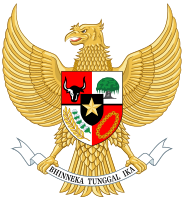Presidential Cabinet (Indonesia)
| Presidential Cabinet | |
|---|---|
|
1st cabinet of Indonesia |
|
| Indonesian Government (Executive Branch) | |
 |
|
| Date formed | 19 August 1945 |
| Date dissolved | 14 November 1945 |
| People and organisations | |
| Head of state | Sukarno |
| Head of government | Sukarno |
| No. of ministers | 24 |
| History | |
| Successor | Sjahrir I |
The Presidential Cabinet (Indonesian: ) was the first cabinet established by Indonesia following the 17 August 1945 Indonesian Declaration of Independence. It comprised 20 ministers and four officials. Its term of office ran from 2 September to 14 November 1945.
Indonesian had been under Japanese occupation since 1942, but by 1943, realizing they were losing the war, the Japanese appointed Indonesian advisors (sanyo) to the administration and appointed nationalist leader Sukarno leader of a new Central Advisory Board (Chuo Sani-kai) in Jakarta On 7 August, the day after the atomic bombing of Hiroshima, the Preparatory Committee for Indonesian Independence (Indonesian: Panitia Persiapan Kemerdekaan Indonesia) or PPKI was established. Sukarno was chairman, and Hatta vice-chairman. On 19 August 1945, this body created 12 ministries for Indonesia's first cabinet. The cabinet as formed contained sanyo as well as officials who had not worked with the Japanese. The cabinet was responsible to President Sukarno.
On 22 September 1945, Finance Minister Samsi was replaced by A.A. Maramis on health grounds. In a government decree on 6 October, Soeprijadi, a hero of the Blitar rebellion against the occupying Japanese, was officially appointed defense minister. However, as no news was ever heard of him, on 20 October Muhammad Soeljoadikusuma was appointed ad interim defense minister. Attorney General Gatot Tarunamihardja resigned on 24 October. As a temporary measure, Chief Justice Kusumah Atmaja was appointed acting attorney general. Kasman Singodiedjo was appointed to the post on 7 November.
On 11 November 1945, the Central Indonesian National Committee, which was the de facto legislature, demanded the cabinet be responsible to it, not to President Sukarno. Sukarno agreed to this and dismissed the cabinet.
...
Wikipedia
